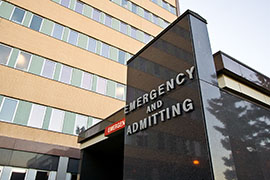National Report Card Gives Arizona a Grade of D+ for Emergency Care

WASHINGTON – Arizona got a D+ for the quality of its emergency medical care, but that was the average grade for states on a national report card released Thursday. Arizona’s grade on the American College of Emergency Physicians report was unchanged from the last report in 2009, while the national grade fell from C- to an “alarming” D+.
“Congress and the president must take action and make emergency care a national priority,” ACEP President Alex Rosenau said in a conference call Thursday to release the study. “This (report) is an opportunity to improve.”
The report rated states in five areas: access to emergency care, quality of care, the medical liability atmosphere, public health initiatives and disaster preparedness.
Arizona did relatively well for the quality of its emergency care, getting a grade of B- and finishing 14th among states. But it got an F for access to care, ranking 48th.
It was not alone: Twenty-one states got an F for their physical and financial access to emergency care.
“This is alarming,” said Jon Mark Hirshon, a professor at University of Maryland’s School of Medicine, who presented the report. “We want to make sure people have access to care, and if they don’t have access to care, then there’s a real problem.”
Patricia Bayless, president of Arizona College of Emergency Physicians, said the state simply lacks the resources to cope with the demands of a growing population.
“It’s kind of like the phrase, ‘If you build it, they will come,’” Bayless said. “Except it’s the opposite for us. The people are already here.”
She said one of the biggest problems is the lack of resources for mental health patients in the state.
“We need to devote more resources to mental health care,” Bayless said. “There is a severe shortage in beds … there are patients who wait literally days to get in.”
She said the number of doctors and nurses in the state has not kept pace with its population growth since 2009, which explains the state’s stagnant overall grade. With demand growing and resources shrinking, she said, many people are forced to wait days for care.
Bayless noted that while there are more medical students in Arizona today, it will take years before they will be able to treat people.
“The number of medical students in the state has increased exponentially in the last 10 years,” she said. “But then you add on four more years of med school, and three more years of training … and they have all these years of training and they aren’t through the pipeline yet.”
In the meantime, she said, there needs to be an increase in funding to train those doctors and nurses – a greater number of healthcare providers generally will help relieve pressure on emergency rooms, she said.
Rosenau said that because emergency medical care is such a critical part of the healthcare system, the nation needs to focus on building those resources and improving the opportunity to receive care.
“The nation’s emergency departments are being unsupported by government policy,” said Rosenau, who said that “lives are at stake.”















